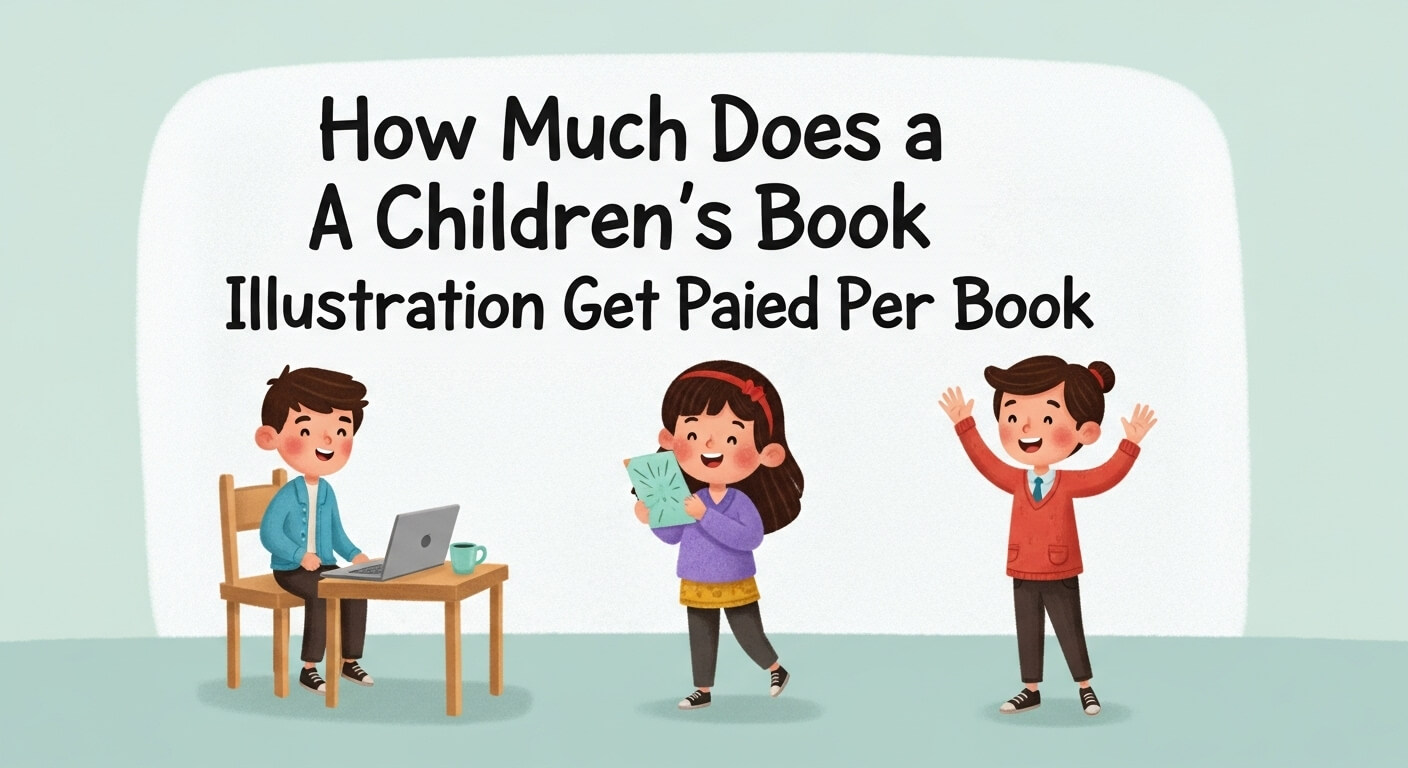How Much Does a Children’s Book Illustrator Get Paid Per Book?
Illustrate Now
If you’ve ever flipped through a children’s picture book, you’ve probably noticed how the illustrations bring the story to life. Every vibrant page helps capture a child’s imagination, and behind those illustrations is a talented artist who spent hours designing characters, scenes, and emotions. But one question authors, publishers, and aspiring illustrators often ask is: How much does a children’s book illustrator get paid per book?
The answer isn’t simple, it depends on many factors including experience, publishing model, project scope, and licensing rights. In this comprehensive guide, we’ll break down illustrator pay rates, fee models, royalty structures, and cost factors to help you understand what’s fair and realistic in today’s children’s book market.
Table of Contents
ToggleThe Role of a Children’s Book Illustrator
Before diving into numbers, it’s worth understanding what a children’s book illustrator actually does. Their work involves far more than simply drawing pictures.
Illustrators are visual storytellers. They interpret an author’s words and transform them into images that children can understand and connect with emotionally. In a typical 24–32 page picture book, illustrators may be responsible for:
- Designing the main characters and their expressions
- Creating the setting and backgrounds
- Planning visual flow and layout for each page
- Choosing color palettes that evoke the right emotions
- Preparing final artwork for print or digital publishing
This creative process can take weeks or even months, so it’s easy to see why professional illustrators charge substantial fees for their time and expertise.
Average Pay for Children’s Book Illustrators
There are two main payment structures for illustrators:
- Flat Fee (Work-for-Hire)
- Advance + Royalties (Traditional Publishing)
Let’s explore both models in detail.
Flat Fee (Work-for-Hire)
In a flat fee agreement, the illustrator is paid a fixed amount for the entire book. The client — usually a self-publishing author — pays this upfront or in milestones. Once payment is complete, the illustrator typically transfers usage rights or full ownership of the artwork.
Average range (global market):
- Small or indie projects: $3,000 – $8,000 per book
- Mid-level illustrators: $8,000 – $15,000 per book
- Top-tier professionals: $15,000 – $30,000+ per book
Per-page pricing can range from:
- $50 – $150 for simple spot illustrations
- $300 – $800 for detailed full-page color illustrations
Example:
A 32-page picture book with 15 full-page spreads and a cover could cost anywhere from $5,000 to $12,000, depending on the illustrator’s skill and licensing terms.
Advance + Royalties (Traditional Publishing)
In traditional publishing, illustrators often receive an advance payment plus a royalty percentage on book sales. This is the standard model for books published by established publishers like Penguin Random House, HarperCollins, or Scholastic.
Typical structure:
- Advance: $5,000 – $20,000 (paid in installments)
- Royalties: 3.5% – 6% of retail price (sometimes shared with the author)
For example, if a book sells 10,000 copies at $15 each and the illustrator earns 5% of the retail price, they would earn $7,500 in royalties, after the advance is “earned out.”
However, not all books sell enough copies to exceed the advance, so many illustrators primarily rely on that initial payment.
Factors That Affect an Illustrator’s Pay
There’s no fixed rate for children’s book illustration because every project is unique. The following key factors determine how much an illustrator gets paid:
Experience and Portfolio
A beginner illustrator might charge a few thousand dollars, while award-winning professionals can demand $20,000+ per project. An illustrator’s portfolio, style, and published track record heavily influence pricing.
Number of Illustrations
A short storybook with a few spot illustrations will cost less than a 32-page picture book with full-color spreads. Each page takes hours to plan, sketch, and color.
Level of Detail
Illustrations that include complex backgrounds, multiple characters, or intricate linework require more time — and therefore command higher fees.
Rights and Licensing
If an author wants exclusive rights or intends to use the artwork for merchandise, marketing, or sequels, the cost rises. Non-exclusive or limited-use agreements are cheaper.
Deadline and Turnaround Time
Rush projects (e.g., completion within a few weeks) typically incur a 20–50% premium because they demand extra working hours.
Publishing Model
Traditional publishers pay more consistently, while self-publishing budgets vary widely depending on the author’s financial capacity.
Regional Variations in Illustrator Rates
Illustrator pay differs significantly between countries and regions due to cost of living, demand, and market expectations.
United States & Canada
- Typical book project: $5,000 – $15,000+
- High-profile illustrators can earn $20,000 – $40,000 per book
- Royalties: 3.5%–6% (standard industry range)
United Kingdom
- Flat fees: £2,000 – £10,000 per book
- Royalties: 3%–5% of net sales
- Experienced illustrators charge higher for exclusive rights
Australia
- Picture book rates: AUD 4,000 – AUD 12,000
- Royalties: 5%–6% on average
South Asia (India, Pakistan, Bangladesh)
- Local illustrators: USD 1,000 – 5,000 per full book project
- Per illustration: USD 30 – 200 depending on complexity
- Many authors hire international illustrators through platforms like Upwork, Behance, or Fiverr to balance quality and cost
Europe (Western & Nordic Countries)
- Flat fee: €5,000 – €20,000
- Royalties: 4%–6% standard
- Union guidelines often set minimum pay rates
How Illustrators Set Their Rates
Most professional illustrators calculate their rates based on time, effort, and licensing rather than a flat per-page price.
A common formula looks like this:
Rate = (Hourly Rate × Estimated Hours) + Licensing Fees
For example:
If an illustrator charges $40/hour and estimates 120 hours of work for a full book, that’s $4,800. Adding a 25% licensing fee (for exclusive usage) would bring the total to $6,000.
Some illustrators use tiered pricing, such as:
- Basic (personal or limited rights): $3,000
- Standard (exclusive book rights): $5,000
- Premium (all rights + commercial use): $8,000+
This flexible approach allows clients to choose based on budget and intended usage.
Royalty Agreements Explained
If you’re publishing traditionally, understanding royalties is essential. Here’s a breakdown of how it works.
What Are Royalties?
Royalties are a percentage of the book’s sales that the illustrator earns in addition to (or after recouping) their advance payment.
Common Royalty Rates
- Picture Books (illustrator only): 5% – 6% of retail price
- Shared Credit (author + illustrator): 2% – 3% each
- Middle-grade or chapter books: 1% – 3% (fewer illustrations)
How Royalties Are Paid
Royalties are usually paid twice a year once the publisher’s accounting cycle closes. The illustrator only receives royalties after the advance has been “earned out.”
Advantages and Disadvantages
Pros:
- Potential for long-term income
- Alignment with book success
- Credibility boost from working with established publishers
Cons:
- Requires patience — royalties can take years to accumulate
- Not guaranteed beyond the advance
- Limited creative control compared to self-publishing
Self-Publishing and Hiring Freelance Illustrators
With platforms like Amazon KDP, IngramSpark, and Blurb, self-publishing has exploded in popularity. Many independent authors hire illustrators directly.
When working with freelancers, payment is usually made in milestones, such as:
- 25% deposit upfront
- 50% upon sketch approval
- 25% upon final delivery
Contracts should always specify:
- Number of illustrations and revisions
- Delivery timelines
- Licensing and ownership rights
- Payment structure and method
Pro Tip:
Never skip a written contract. It protects both the author and illustrator by clearly defining scope and expectations.
Budgeting Tips for Authors
If you’re an author planning to publish a children’s book, here are some cost-saving tips:
- Plan Your Visual Style Early: Minimalist or stylized art can cost less than highly detailed, realistic illustrations.
- Bundle Work: Hiring the same illustrator for the cover and interior can reduce overall cost.
- Negotiate Rights: Consider non-exclusive or limited rights if you don’t need full ownership.
- Use Payment Milestones: This spreads the cost and helps maintain quality control.
- Hire Regionally: Artists from South Asia or Eastern Europe often offer competitive pricing with excellent quality.
How Illustrators Can Increase Their Income
For illustrators themselves, here are a few ways to boost earnings:
- Build a strong portfolio: Show variety in style, composition, and color.
- Join agencies: Art reps or illustration agencies connect artists with publishers.
- Offer licensing options: Sell prints, merchandise, or digital downloads of your art.
- Develop your own IP: Create and illustrate your own children’s books for passive income.
- Market your work: Use Behance, Instagram, and LinkedIn to attract commissions.
Sample Cost Breakdown (Case Study)
Let’s look at a realistic example of how much a self-publishing author might pay.
| Task | Description | Estimated Cost |
|---|---|---|
| Character design | 3 main characters | $600 |
| Cover illustration | Full color, detailed | $400 |
| 15 full-page illustrations | Full color spreads | $4,500 |
| 10 small spot illustrations | Simpler images | $800 |
| File formatting & revisions | Print-ready adjustments | $300 |
| Total Estimated Cost | $6,600 |
This mid-range estimate gives you a good sense of how a professional-quality picture book illustration budget might look.
Freelance Platforms and Agencies
When hiring, look for:
- A consistent style that matches your story’s tone
- Experience with book layouts and printing specs
- Positive client reviews
- Willingness to sign a clear contract
Future Trends in Children’s Book Illustration
The children’s publishing industry continues to evolve. Here are some trends affecting illustrator pay:
- Digital-first publishing: E-books and audiobooks with interactive illustrations are rising.
- AI-assisted art: Some artists use AI tools for concept sketches, but final artwork still requires human creativity.
- Diverse representation: Publishers are actively seeking illustrators who can portray inclusive characters and cultures.
- Hybrid models: Many illustrators now combine flat fees with partial royalties for shared success.
These shifts suggest that illustrators with digital skills and versatility will have higher earning potential in the coming years.
Conclusion: What’s a Fair Rate for a Children’s Book Illustrator?
So, how much does a children’s book illustrator get paid per book?
- Self-published books: $3,000 – $15,000 on average
- Traditional publishing: $5,000 – $20,000 advance + 3.5%–6% royalties
- Per illustration: $50 – $500 (depending on complexity and experience)
The key takeaway is that illustration is an art form — not just decoration. When you hire an illustrator, you’re investing in creativity, storytelling, and visual impact that will define your book’s success.
Whether you’re an author looking for the perfect artist or an illustrator setting your rates, remember: good art takes time, skill, and heart — and that’s worth fair pay.







